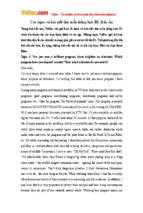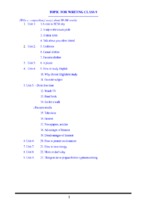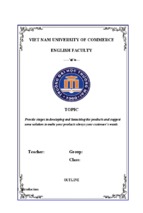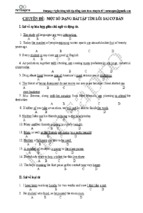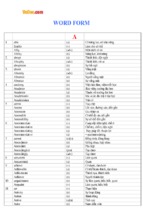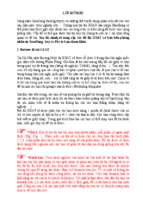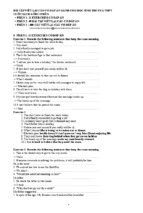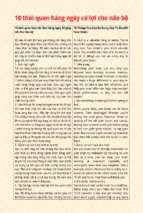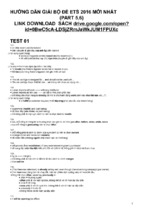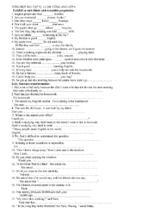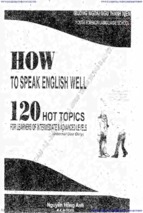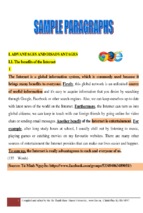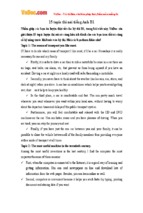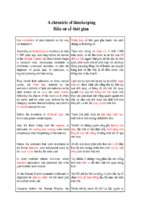Các dạng viết theo chart, biểu đồ của IELTS
IELTS Writing Task 1 Simon
Contents
1. Line graph ............................................................................................................................... 3
1.1.
Tips for Line graph ........................................................................................................... 3
1.2.
Internet Users as percentage of population ...................................................................... 4
1.3.
International migration in UK .......................................................................................... 6
1.4.
UK acid rain emission ...................................................................................................... 8
1.5.
Water consumption (DẠNG MIX) .................................................................................. 9
1.6.
Car ownership ................................................................................................................ 10
1.7.
fdvProportion of the population ..................................................................................... 12
1.8.
US consumers' average annual expenditures ................................................................. 13
1.9.
Number of UK commuters travelling............................................................................. 15
1.10.
The graph below shows changes in young adult unemployment rates in England
between 1993 and 2012. ........................................................................................................... 16
2.
3.
Bar chart ................................................................................................................................ 17
2.1.
Marriages and divorces .................................................................................................. 17
2.2.
Levels of participation .................................................................................................... 18
2.3.
Consumer good .............................................................................................................. 21
2.4.
House prices ................................................................................................................... 22
2.5.
Chart without years' essay: ............................................................................................. 24
2.6.
STACKED BAR CHART ESSAY ................................................................................ 26
2.7.
The global sales of different types of digital games....................................................... 27
Table ..................................................................................................................................... 28
3.1.
Tips for table .................................................................................................................. 28
3.2.
Rail networks.................................................................................................................. 29
3.3.
Poverty proportion in Australia ...................................................................................... 30
3.4.
Daily activities................................................................................................................ 33
3.5.
Goods consumer ............................................................................................................. 34
3.6.
Percentages of mobile phone owners ............................................................................. 36
3.7.
IELTS Writing Task 1: too many numbers!................................................................... 37
Writing Task 1 - Simon
Collected by Ngoc Bach
Page 1
3.8.
4.
5.
6.
7.
The Amount of waste ..................................................................................................... 38
Pie chart ................................................................................................................................ 39
4.1.
Cam7, page 101 .............................................................................................................. 39
4.2.
Diet ................................................................................................................................. 41
4.3.
3 PIE CHART ................................................................................................................ 42
4.4.
4 PIE CHARTS .............................................................................................................. 43
Map ....................................................................................................................................... 44
5.1.
Village of Chorleywood ................................................................................................. 44
5.2.
Gallery ............................................................................................................................ 45
5.3.
House design .................................................................................................................. 46
5.4.
2 proposed supermarket ................................................................................................. 48
PROCESS ............................................................................................................................. 51
6.1.
Forecast in Australia....................................................................................................... 52
6.2.
Brick manufactuting ....................................................................................................... 54
6.3.
Water cycle ..................................................................................................................... 55
6.4.
The process of waster paper : flow chart........................................................................ 59
6.5.
The life cycle of the honey bee. ..................................................................................... 60
6.6.
Solar panels .................................................................................................................... 62
Dạng MIX: ............................................................................................................................ 63
7.1.
2 bar chart ....................................................................................................................... 63
7.2.
2 bar chart age group charts ........................................................................................... 63
7.3.
BAR CHART & LINE CHART: ................................................................................... 63
Writing Task 1 - Simon
Collected by Ngoc Bach
Page 2
1. Line graph
1.1. Tips for Line graph
Line graphs always show changes over time. Here's some advice about how to describe them:
Try to write 4 paragraphs - introduction, summary of main points, 2 detail paragraphs.
For your summary paragraph, look at the "big picture" - what changes happened to all of
the lines from the beginning to the end of the period shown (i.e. from the first year to the
last). Is there a trend that all of the lines follow (e.g. an overall increase)?
You don't need to give numbers in your summary paragraph. Numbers are specific
details. Just mention general things like 'overall change', 'highest' and 'lowest', without
giving specific figures.
Never describe each line separately. The examiner wants to see comparisons.
If the graph shows years, you won't have time to mention all of them. The key years to
describe are the first year and the last year. You should also mention any 'special' years
(e.g. a peak or a significant rise/fall).
Start describing details (paragraph 3) with a comparison of the lines for the first year
shown on the graph (e.g. in 1990, the number of...).
Use the past simple (increased, fell) for past years, and 'will' or 'is expected/predicted to'
for future years.
Don't use the passive (e.g. the number was increased), continuous (e.g. the number was
increasing), or perfect tenses (e.g. the number has increased).
Writing Task 1 - Simon
Collected by Ngoc Bach
Page 3
1.2.Internet Users as percentage of population
The line graph compares the percentage of people in three countries who used the Internet
between 1999 and 2009.
It is clear that the proportion of the population who used the Internet increased in each country
over the period shown. Overall, a much larger percentage of Canadians and Americans had
access to the Internet in comparison with Mexicans, and Canada experienced the fastest growth
in Internet usage.
In 1999, the proportion of people using the Internet in the USA was about 20%. The figures for
Canada and Mexico were lower, at about 10% and 5% respectively. In 2005, Internet usage in
both the USA and Canada rose to around 70% of the population, while the figure for Mexico
reached just over 25%.
By 2009, the percentage of Internet users was highest in Canada. Almost 100% of Canadians
used the Internet, compared to about 80% of Americans and only 40% of Mexicans.
Writing Task 1 - Simon
Collected by Ngoc Bach
Page 4
USEFUL COMMENTS:
hi
can
i
write"among
the
three
countries"
instead
of
can i write the figures for internet users "fluctuated" in usa during 2000 and 2009.
simon
"overall"
Posted by: sohaib | Wednesday, February 01, 2012 at 15:18
Hi Sohaib,
"among the three countries" is fine.
"fluctuated" is fine, but use "between...and..." instead of "during".
Writing Task 1 - Simon
Collected by Ngoc Bach
Page 5
1.3.International migration in UK
The chart gives information about UK immigration, emigration and net migration between 1999
and 2008.
Both immigration and emigration rates rose over the period shown, but the figures for
immigration were significantly higher. Net migration peaked in 2004 and 2007.
In 1999, over 450,000 people came to live in the UK, while the number of people who emigrated
stood at just under 300,000. The figure for net migration was around 160,000, and it remained at
a similar level until 2003. From 1999 to 2004, the immigration rate rose by nearly 150,000
people, but there was a much smaller rise in emigration. Net migration peaked at almost 250,000
people in 2004.
After 2004, the rate of immigration remained high, but the number of people emigrating
fluctuated. Emigration fell suddenly in 2007, before peaking at about 420,000 people in 2008. As
a result, the net migration figure rose to around 240,000 in 2007, but fell back to around 160,000
in 2008.
(159)
Writing Task 1 - Simon
Collected by Ngoc Bach
Page 6
USEFUL COMMENTS:
1)
Q:
Hi Simon,
In this type of question should you try to express the numbers in other ways,
For example "a 50% rise in immigration" or "Emigration increased by a third"
Also, is just copying numbers what the public rubric terms 'mechanical' (i.e Band 5 for Task
Achievement) ?
A:
Hi Dave,
Don't worry too much about expressing numbers in a different way. It can be nice for variety, but
in my experience it also leads to mistakes and loss of clarity.
"Mechanical description" doesn't refer to copying the numbers. It refers, in the case of a graph, to
describing each line separately from beginning to end with no comparisons between each line. A
mechanical description would be like a list (e.g. the number increased, then it decreased before
rising again etc. etc.)
Hope this helps
Writing Task 1 - Simon
Collected by Ngoc Bach
Page 7
1.4.UK acid rain emission
The graph below shows UK acid rain emissions, measured in millions of tones, from four
different sectors between 1990 and 2007.
I've made the following essay into a gap-fill exercise.
The line graph compares four sectors in ______ of the amount of acid rain emissions that they
produced over a period of 17 years in the UK.
It is clear that the total amount of acid rain emissions in the UK ______ ______ between 1990
and 2007. The most ______ decrease was seen in the electricity, gas and water supply sector.
In 1990, around 3.3 million tones of acid rain emissions came from the electricity, gas and water
sector. The transport and communication sector was ______ for about 0.7 million tones of
emissions, while the domestic sector ______ around 0.6 million tones. Just over 2 million tones
of acid rain gases came from other industries.
Emissions from electricity, gas and water supply fell dramatically to only 0.5 million tones in
2007, a ______ of almost 3 million tones. While acid rain gases from the domestic sector and
other industries fell gradually, the transport sector ______ a small increase in emissions, ______
a peak of 1 million tones in 2005.
Fill the gaps using these words:
terms, fell considerably, dramatic,responsible,produced,drop,saw,reaching
Writing Task 1 - Simon
Collected by Ngoc Bach
Page 8
1.5.Water consumption (DẠNG MIX)
The graph and table below give information about water use worldwide and water
consumption in two different countries.
The charts compare the amount of water used for agriculture, industry and homes around the
world, and water use in Brazil and the Democratic Republic of Congo.
It is clear that global water needs rose significantly between 1900 and 2000, and that agriculture
accounted for the largest proportion of water used. We can also see that water consumption was
considerably higher in Brazil than in the Congo.
In 1900, around 500km³ of water was used by the agriculture sector worldwide. The figures for
industrial and domestic water consumption stood at around one fifth of that amount. By 2000,
global water use for agriculture had increased to around 3000km³, industrial water use had risen
to just under half that amount, and domestic consumption had reached approximately 500km³.
In the year 2000, the populations of Brazil and the Congo were 176 million and 5.2 million
respectively. Water consumption per person in Brazil, at 359m³, was much higher than that in the
Congo, at only 8m³, and this could be explained by the fact that Brazil had 265 times more
irrigated land.
Writing Task 1 - Simon
Collected by Ngoc Bach
Page 9
(184 words, band 9)
USEFUL COMMENTS:
Q:
hi
simon,
i want ask about the grammer of the third paragraph , you are using the paste simple in when you
talking about the year 1900 and use the past perfect in 2000 , what i ask about that i learned that
the action which happened in the past first will be in the past perfect and the nearest one will be
at the past simple .is this role right ?
waiting ur replay , Thanks in advance .
Posted by: hesham | Tuesday, December 13, 2011 at 05:02
simon , am waiting ur replay pls .
Posted by: hesham | Wednesday, December 14, 2011 at 08:24
A
Hi Hesham,
I can understand why you are confused. The reason I used 'past perfect' with 2000 is because I
used the word "by" (by 2000...).
When you write "by 2000" it means that you are describing what happened "before and until
2000". "2000" is in the past, and "by 2000" includes what happened BEFORE that year.
When I wrote about 1900, I was writing only about that year, not about what happened BEFORE
it.
As you can see, the rule that you learned is a bit too simple. If you are confused by the past
perfect, just use the past simple only.
1.6.Car ownership
The graph below gives information about car ownership in Britain from 1971 to 2007.
Writing Task 1 - Simon
Collected by Ngoc Bach
Page 10
The graph shows changes in the number of cars ______ household in Great Britain ______ a
period of 36 years.
Overall, car ownership in Britain increased ______ 1971 and 2007. In particular, the number of
households with two cars rose, while the number of households ______ a car fell.
In 1971, ______ half of all British households did not have regular use of a car. Around 44% of
households had one car, but only about 7% had two cars. It was uncommon for families to own
three or more cars, ______ around 2% of households falling into this category.
The one-car household was the most common type from the late 1970‟s ______, although there
was little change in the ______ for this category. The biggest change was seen in the proportion
of households without a car, which fell steadily over the 36-year period ______ around 25% in
2007. In contrast, the proportion of two-car families rose steadily, reaching about 26% in 2007,
and the proportion of households with more than two cars rose ______ around 5%.
Fill the gaps in the essay with the following words:
almost, to, figures, per, between, by, over, with, without, onwards
Hi, Simon,could you give me some suggestions on each paragraph? And I find that I have used"
the proportion ,and the percentage" too many times. How can I solve this problem?
Writing Task 1 - Simon
Collected by Ngoc Bach
Page 11
Paragraph1:The line graph below gives information about the variation in the percentage of
households that owned no car, one car and two or more cars in the UK over a period of 36 years.
Paragraph2:It is clear that the proportion of families with 2 cars increased dramatically over the
period shown while the figure for families without cars dropped considerably.
Paragraph3:In 1971, the percentages of British homes that owned two cars and three or more cars
stood at about 2% and 7% respectively. By contrast,around 45% of British families used one car
compared to about 48% of families without cars.
Paragraph4:The next twenty years saw a slight increase in the percentage of households with
three or more cars. However,the figure for families with no cars remained stable from 1971 to
2007.During the same period, the proportion of families with two cars rose significantly to
approximately 26% whereas the figure for those without cars dropped shaply to 25%.
Bài mẫu của Adverb
1.7.fdvProportion of the population
The graph below shows the proportion of the population aged 65 and over between 1940
and 2040 in three different countries.
Writing Task 1 - Simon
Collected by Ngoc Bach
Page 12
.
The line graph compares the percentage of people aged 65 or more in three countries over a
period of 100 years.
It is clear that the proportion of elderly people increases in each country between 1940 and 2040.
Japan is expected to see the most dramatic changes in its elderly population.
In 1940, around 9% of Americans were aged 65 or over, compared to about 7% of Swedish
people and 5% of Japanese people. The proportions of elderly people in the USA and Sweden
rose gradually over the next 50 years, reaching just under 15% in 1990. By contrast, the figures
for Japan remained below 5% until the early 2000s.
Looking into the future, a sudden increase in the percentage of elderly people is predicted for
Japan, with a jump of over 15% in just 10 years from 2030 to 2040. By 2040, it is thought that
around 27% of the Japanese population will be 65 years old or more, while the figures for
Sweden and the USA will be slightly lower, at about 25% and 23% respectively.
(178 words, band 9)
IELTS Writing Task 1: analyse model essays
Maybe you read my line graph essay last week, but did you really study it?
Here's some example analysis of last week's essay:
Structure - 4 paragraphs: introduction, overview, 2 specific details
Paraphrasing - proportion of the population = percentage of people (find more
examples)
Overview - overall trend, then biggest change
Selecting key information - first year (1940), middle years (1990, early 2000s), end of
period (2030 to 2040)
Comparing - in each country, most dramatic, and, compared to, by contrast, while,
slightly lower, respectively (analyse my sentences to learn how to use these words
correctly)
Verbs - compares, increases, is expected to see, were, rose, remained... (look carefully
at the use of tenses)
It's possible to read model essays quickly and learn a little. It's also possible to spend a long time
studying them carefully and learn a lot!
US consumers' average annual expenditures
Writing Task 1 - Simon
Collected by Ngoc Bach
Page 13
The graph below shows US consumers' average annual expenditures on cell phone and
residential phone services between 2001 and 2010.
The line graph compares average yearly spending by Americans on mobile and landline phone
services from 2001 to 2010.
It is clear that spending on landline phones fell steadily over the 10-year period, while mobile
phone expenditure rose quickly. The year 2006 marks the point at which expenditure on mobile
services overtook that for residential phone services.
In 2001, US consumers spent an average of nearly $700 on residential phone services, compared
to only around $200 on cell phone services. Over the following five years, average yearly
spending on landlines dropped by nearly $200. By contrast, expenditure on mobiles rose by
approximately $300.
In the year 2006, the average American paid out the same amount of money on both types of
phone service, spending just over $500 on each. By 2010, expenditure on mobile phones had
reached around $750, while the figure for spending on residential services had fallen to just over
half this amount.
(162 words, band 9)
NOTED:
In last week's line graph essay I repeated the word "expenditure" four times. Is this a problem?
The answer is no! If you look at the graph, you can see that the whole essay must be about
expenditure. In fact, I needed to mention the idea of expenditure eleven times! Does the
examiner really expect you to think of eleven synonyms for "expenditure"? Of course not.
Writing Task 1 - Simon
Collected by Ngoc Bach
Page 14
.
It's impossible to avoid repeating some of the key words in writing task 1. Try to add variety
where you can (I also used "spending", "spent" and "paid out"), but don't become obsessed with
this. The important thing is to describe and compare the data.
Number of UK commuters travelling
The graph below shows the average number of UK commuters travelling each day by car, bus
or train between 1970 and 2030.
Here's the essay I wrote with my students' help:
The line graph compares figures for daily travel by workers in the UK using three different forms
of transport over a period of 60 years.
It is clear that the car is by far the most popular means of transport for UK commuters
throughout the period shown. Also, while the numbers of people who use the car and train
increase gradually, the number of bus users falls steadily.
In 1970, around 5 million UK commuters travelled by car on a daily basis, while the bus and
train were used by about 4 million and 2 million people respectively. In the year 2000, the
number of those driving to work rose to 7 million and the number of commuting rail passengers
reached 3 million. However, there was a small drop of approximately 0.5 million in the number
of bus users.
Writing Task 1 - Simon
Collected by Ngoc Bach
Page 15
By 2030, the number of people who commute by car is expected to reach almost 9 million, and
the number of train users is also predicted to rise, to nearly 5 million. By contrast, buses are
predicted to become a less popular choice, with only 3 million daily users.
1.10. The graph below shows changes in young adult unemployment rates in England between
1993 and 2012.
Introduction and overview paragraphs:
The line graph compares levels of unemployment among 16 to 24-year-olds with overall
unemployment figures over a period of 20 years in England.
It is clear that the proportion of young adults who were unemployed at any time between 1993
and 2012 was significantly higher than the overall proportion of adults without work.
Unemployment rates for both groups of adults were consistently higher in London than in the
rest of England.
Writing Task 1 - Simon
Collected by Ngoc Bach
Page 16
2. Bar chart
2.1.Marriages and divorces
The first bar chart shows changes in the number of marriages and divorces in the USA, and the
second chart shows figures for the marital status of American adults in 1970 and 2000.
It is clear that there was a fall in the number of marriages in the USA between 1970 and 2000.
The majority of adult Americans were married in both years, but the proportion of single adults
was higher in 2000.
In 1970, there were 2.5 million marriages in the USA and 1 million divorces. The marriage rate
remained stable in 1980, but fell to 2 million by the year 2000. In contrast, the divorce rate
peaked in 1980, at nearly 1.5 million divorces, before falling back to 1 million at the end of the
period.
Writing Task 1 - Simon
Collected by Ngoc Bach
Page 17
Around 70% of American adults were married in 1970, but this figure dropped to just under 60%
by 2000. At the same time, the proportion of unmarried people and divorcees rose by about 10%
in total. The proportion of widowed Americans was slightly lower in 2000.
(174)
2.2.Levels of participation
The charts below show the levels of participation in education and science in developing and
industrialised countries in 1980 and 1990.
Writing Task 1 - Simon
Collected by Ngoc Bach
Page 18
The three bar charts show average years of schooling, numbers of scientists and technicians, and
research and development spending in developing and developed countries. Figures are given for
1980 and 1990.
It is clear from the charts that the figures for developed countries are much higher than those for
developing nations. Also, the charts show an overall increase in participation in education and
science from 1980 to 1990.
People in developing nations attended school for an average of around 3 years, with only a
slight increase in years of schooling from 1980 to 1990. On the other hand, the figure for
industrialised countries rose from nearly 9 years of schooling in 1980 to nearly 11 years in
1990.
From 1980 to 1990, the number of scientists and technicians in industrialised countries almost
doubled to about 70 per 1000 people. Spending on research and development also saw rapid
growth in these countries, reaching $350 billion in 1990. By contrast, the number of science
workers in developing countries remained below 20 per 1000 people, and research spending fell
from about $50 billion to only $25 billion.
(187 words)
USEFUL COMMENTS:
1)
Thanks for your contributions. You have all got the right idea.
I think there are 2 key things to notice for the "overview" or summary paragraph:
1. The figures for industrialised countries are/were much higher.
2. There is/was an overall increase in participation in education and science from 1980 to 1990
(for the moment, we can ignore the one figure that decreased).
So, here's my overview. Remember, it comes after the introduction (in which I would already
have mentioned that what figures in each chart refer to).
OVERVIEW:
It is clear from the three charts that the figures for developed countries are much higher than
those for developing nations. Also, the charts show an overall increase in participation in
education and science from 1980 to 1990.
Keep working hard!
Simon
2)
Writing Task 1 - Simon
Collected by Ngoc Bach
Page 19
Writing Task 1 - Simon
Collected by Ngoc Bach
Page 20
- Xem thêm -


